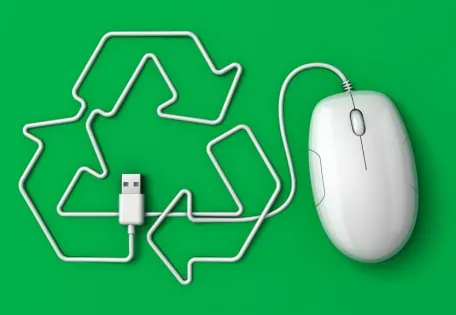
When and how should a business decide on asset disposal? For business owners, the answer to this question isn't always clear. There are many factors to consider when determining whether it’s appropriate to dispose of an asset, and certain types of assets must be disposed of in a specific way to maintain customer privacy and data security.
The following factors call for the immediate disposal of physical assets:
- The equipment is no longer working and cannot be salvaged.
- The equipment no longer supports your current needs.
- The equipment is old and no longer meets company standards.

There are situations in which the need for disposal isn’t as obvious as those listed above; for example, the equipment may be running sluggishly or breaking down frequently and forcing you to pay for repairs. The cost of replacing the equipment may seem too costly. However, by calculating the amount of time and money spent supporting or repairing ineffective equipment, you may find the cost of replacement to be less than maintaining the old and inefficient. Especially if having the equipment off-line forces production to stop (downtime) or keeps employees from completing their jobs efficiently and in a timely manner. Additionally, if the equipment can be sold as a whole or in pieces, that money can be used to invest in newer more reliable equipment.
Downtime costs every factory at least 5% of its productive capacity, and many lose up to 20%. An estimated 80% of industrial facilities are unable to accurately estimate their total downtime cost (TDC).
- Improper vs. Proper Disposal
Improper disposal can occur at any level within a company. Banks have accidentally thrown out computers
containing confidential client information, and high level executives have sold phones containing valuable company information. A company is financially responsible for all data it stores and can face serious consequences if this data is breached -- especially if the reason for the breach is negligence.
Deleting documents and files stored on a computer cannot always remove all of the data. In fact, there are special programs specifically designed to pull
deleted data from a hard drive. The only way to ensure data remains safe is to have a drive professionally wiped or destroyed.
The U.S. Environmental Protection Agency estimates that more than
500 million tons of electronic waste, including 30 million computers, is created each year.
A small business’s physical assets usually include computers, printers, copiers, tablets, and phones. All IT equipment must be disposed of correctly if you are to preserve the confidentiality of your data. Third-party services are available to wipe hard drives and eliminate any residual information on your IT equipment before it is thrown out. You may be surprised to discover even a copier or a fax machine may contain
confidential documents within its hard drive. Thus, these machines also need to be disposed of carefully. Often, the hard drives can be shredded so important company data is not compromised.
Refurbishing companies often accept old IT equipment, as long as it is still functioning. This can be an excellent way to recapture some value from the IT equipment without having to sell it or worry about it falling into the wrong hands. These companies wipe out the hard drives and fully restore the equipment before reselling the items.
 Recycling assets
Recycling assets is an excellent way to support the environment and remove your company’s old assets. Contacting companies who perform recycling of electronic equipment will educate you as to both your responsibilities and what you can expect from their services. If you want to ensure the safety of your data, remove hard drives for shredding beforehand. Another method for recycling assets involves using the components of older equipment within other machines or simply breaking the equipment down for raw materials.
Recent EPA findings show that
only 25% of all electronics are recycled by the book.
Tracking assets is a significant responsibility of any business – large or small. Detailed information about purchase, maintenance, and physical disposition of assets is required for the reporting of a company’s financial liabilities and worth. As
asset management solution makes the recording of these details possible and allows for the development of protocols for following each asset’s life cycle (including destruction) and ensures an accurate physical inventory and balance sheet.
The disposal of IT assets should be handled in a timely and responsible fashion. While it may seem difficult to properly dispose of a physical asset, it can be equally dangerous to have non-functioning equipment in storage or simply around the office. This equipment is vulnerable as long as it holds data, especially if no one is managing it. A better solution is to assess your physical assets on a regular basis and to properly dispose of any and all obsolete equipment quickly.
 When and how should a business decide on asset disposal? For business owners, the answer to this question isn't always clear. There are many factors to consider when determining whether it’s appropriate to dispose of an asset, and certain types of assets must be disposed of in a specific way to maintain customer privacy and data security.
When and how should a business decide on asset disposal? For business owners, the answer to this question isn't always clear. There are many factors to consider when determining whether it’s appropriate to dispose of an asset, and certain types of assets must be disposed of in a specific way to maintain customer privacy and data security.
 There are situations in which the need for disposal isn’t as obvious as those listed above; for example, the equipment may be running sluggishly or breaking down frequently and forcing you to pay for repairs. The cost of replacing the equipment may seem too costly. However, by calculating the amount of time and money spent supporting or repairing ineffective equipment, you may find the cost of replacement to be less than maintaining the old and inefficient. Especially if having the equipment off-line forces production to stop (downtime) or keeps employees from completing their jobs efficiently and in a timely manner. Additionally, if the equipment can be sold as a whole or in pieces, that money can be used to invest in newer more reliable equipment.
There are situations in which the need for disposal isn’t as obvious as those listed above; for example, the equipment may be running sluggishly or breaking down frequently and forcing you to pay for repairs. The cost of replacing the equipment may seem too costly. However, by calculating the amount of time and money spent supporting or repairing ineffective equipment, you may find the cost of replacement to be less than maintaining the old and inefficient. Especially if having the equipment off-line forces production to stop (downtime) or keeps employees from completing their jobs efficiently and in a timely manner. Additionally, if the equipment can be sold as a whole or in pieces, that money can be used to invest in newer more reliable equipment.
 Recycling assets
Recycling assets